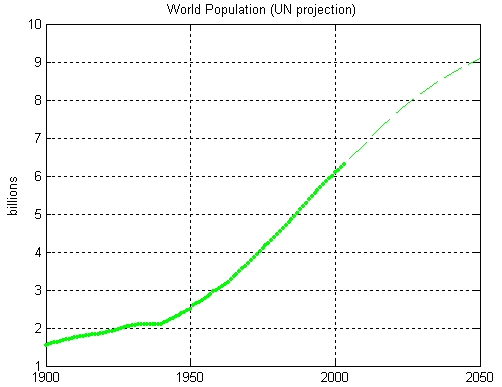Question:
What will be the production pattern if we manage to keep up with the polulation growth as long as we can (magenta points on the graph)?

Figure 1

Figure 2
We assume the following:
1- population grow according to UN prediction (Figure 1)
2- we extract enough oil to maintain a constant number of barrel/capita/year to 4.43 up to 2020 (cumulative production= 1564 Gb)
3- a Verhulst curve model with two values for Q-inf: 2461.82 (BP) and 4173 Gb (USGS)
Results:
The fit is performed by non linear fitting:
- Code: Select all
qinf= 2461.82 Gb: PO date= 2014.81+/- 0.89 PO value= 31.28+/- 0.52 Gb/year
k= 0.04+/- 0.002 n= 0.25+/- 0.14 t_half= 2007.64+/- 0.67
qinf= 4173 Gb: PO date= 2025.74+/- 1.24 PO value= 33.99+/- 0.54 Gb/year
k= 0.04+/- 0.002 n= 1.78+/- 0.23 t_half= 2033.49+/- 0.80
If Q-inf= 2461.82 Gb, the model cannot keep up and the mid-point is reach toward 2007 and the maximum production date is end of 2014 at 31.28 Gb/year. If we manage to grow our reserve as USGS is predicting the mid-point is 2033 and the PO date is 2025 at 34 Gb (see Figure 3).
Figure 4 shows the projected barrel per capita per year according to the two models. We should go back to the 1965 level in 2020 (Q-inf= 2461 Gb) or 2030 (Q-inf= 4173 Gb).

Figure 3

Figure 4
Data source: BP review 2004, World Population Prospects The 2004 Revision Population Database


 , i really appreciate you posting this.
, i really appreciate you posting this.


